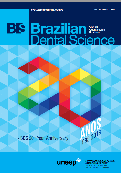Evaluation of the mandibular notch angle in three-dimensional virtual models as a parameter for determining age and sexual dimorphism
DOI:
https://doi.org/10.14295/bds.2018.v21i4.1621Resumo
Objective: The objective of this study was to analyze the opening of the mandibular notch angle (MNA) as a possible tool for predicting sex and estimating age so as to contribute to forensic anthropological studies. Material and Methods: For this, 60 cone beam computed tomographs (CBCT) belonging to the UNESP ICT Radiology archive, were selected: 5 female and 5 male for each decade of life, beginning on twenties until there seventies, totalizing 30 female and 30 male. Three-dimensional models were generated for each exam and measurements were performed with three-dimensional angular measuring tools using OnDemand 3D software (Cybermed Inc., Tustin, CA, USA) on the MNA. The MNA was measured considering the posteriormost portion of the coronoid process, the lowest point of the mandibular notch, and the anteriormost point of the condylar process of the mandible. The Mann-Whitney test was performed with the intention of establishing the possible comparative relationships between the values of angular measurements and sex. Results: No statistically significant differences were found between mandibular incision measurements in both sexes, as well as when comparing the angular measurements of the mandibular incisions and the different age groups studied, when a Kruskall-Wallis test was performed. Conclusion: It was concluded that the structure being evaluated did not appear to be an instrument capable of contributing to forensic anthropology evaluations.
Keywords:
X-ray computed tomography; Forensic anthropology; Legal dentistry; Determination of age by skeleton; Analysis for determination of sex.
Downloads
Downloads
Arquivos adicionais
Publicado
Como Citar
Edição
Seção
Licença
TRANSFERÊNCIA DE DIREITOS AUTORAIS E DECLARAÇÃO DE RESPONSABILIDADE
Toda a propriedade de direitos autorais do artigo "____________________________________________________________________" é transferido do autor(es) para a CIÊNCIA ODONTOLÓGICA BRASILEIRA, no caso do trabalho ser publicado. O artigo não foi publicado em outro lugar e não foi submetido simultaneamente para publicação em outra revista.
Vimos por meio deste, atestar que trabalho é original e não apresenta dados manipulados, fraude ou plágio. Fizemos contribuição científica significativa para o estudo e estamos cientes dos dados apresentados e de acordo com a versão final do artigo. Assumimos total responsabilidade pelos aspectos éticos do estudo.
Este texto deve ser impresso e assinado por todos os autores. A versão digitalizada deverá ser apresentada como arquivo suplementar durante o processo de submissão.
























